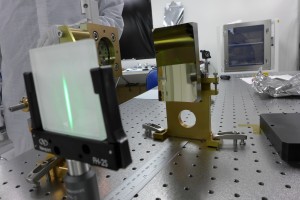This content has been archived. It may no longer be relevant

ICON passes its Critical Design Review
During the review, each instrument and system were reviewed, and plans for integration of these systems onto a unified payload finalized. The team was successful in demonstrating their ability to complete these tasks on schedule. All instruments will be delivered to Utah for integration by the end of the calendar year, before delivery to Orbital ATK in Virginia by May 2016, in preparation for launch in June 2017.
Project Manager Bill Craig said “One of the key strengths was the consistency of the team; we were compared to the high quality expected of a Class B mission; a standard we set for ourself at PDR” and P.I. Thomas Immel complemented the team on an outstanding job in preparing and delivering a very successful review.
After Passing CDR, Alignment and Calibration of the EUV Instrument Begins
ICON’s Extreme Ultraviolet (EUV) instrument is an “imaging spectrometer”. Its 2 dimensional detector records spectral information over the range 58.4 to 83.4 nm in the one direction, and records 12 degree wide x 1/4 degree high slices of the sky over a 16 degree field of view in the other direction.
In preparation for alignment of the toroidal grating used in the EUV instrument, an optical system has been setup to simulate the cylindrical wavefront. This simulates the instrument’s view for each slice of sky while in orbit. The optical set up consists of a convex sphere and a concave toroid that produces a line image on the EUV entrance slit to simulate what EUV will observe in space. This optics pair will be used to first align the EUV instrument using visible light, then the final alignment will take place in a vacuum chamber using EUV radiation, since EUV light is not transmitted in air.
Articles Courtesy of UC Berkeley’s Claire Rafferty

